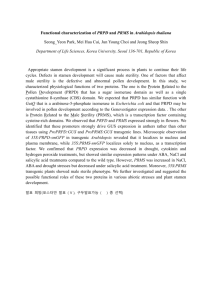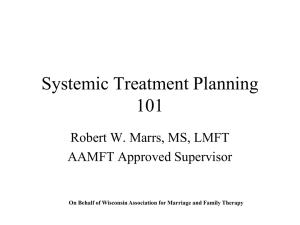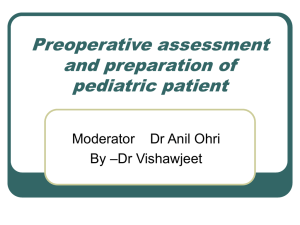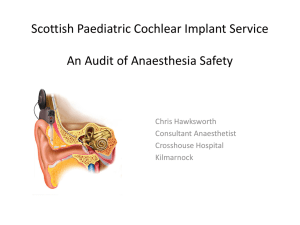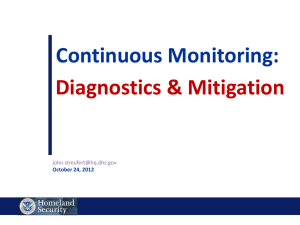ANAESTHESIA
advertisement
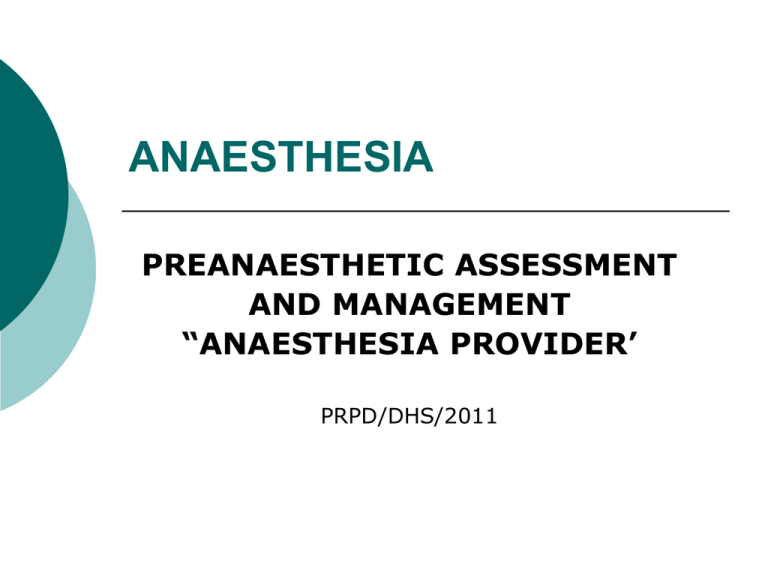
ANAESTHESIA PREANAESTHETIC ASSESSMENT AND MANAGEMENT “ANAESTHESIA PROVIDER’ PRPD/DHS/2011 PREOPERATIVE ASSESSMENT Why preoperative assessment is important? How it should be done? By whom? What can be expected? The importance of test selection based on patient’s needs on scientific evidence of effectiveness. PRPD/DHS/POCN/11 2 THE AIMS OF PREOPERATIVE ASSESSMENT To reduce the risks associated with surgery and anaesthesia. To increase the quality (thus decreasing the cost) of preoperative care. To restore the patient to the desired level of function. To obtain the patients’ informed consent for the anaesthetic procedure. PRPD/DHS/POCN/11 3 1. THE PREOPERATIVE VISIT The main aim of the preoperative visit is to assess the patient’s fitness for anaesthesia. It is performed by an anaesthetist, preferably the one who is going to administer the anaesthetic. All patients would be seen by their anaesthetist sufficiently ahead of the planned surgery to allow any problems identified to be treated without interfering with the smooth running of the operating list. PRPD/DHS/POCN/11 4 THE PREOPERATIVE VISIT cont…. The visit allows the most suitable anaesthetic technique to be determined. To determine any potential interactions between concurrent disease and anaesthesia to be anticipated. To provide an explaination and reassurance for the patient. PRPD/DHS/POCN/11 5 THE PREOPERATIVE VISIT cont… Where there is co-existing illness, every opportunity must be taken to improve the patient’s condition prior to surgery. This may mean seeking advice from other specialists to optimize treatment, although the final decision will rest with the anaesthetist. PRPD/DHS/POCN/11 6 SPECIAL ARRANGEMENTS Three situations: 1. Patients with complex medical or surgical problems; - The patient is often admitted several days prior to surgery. - The anaesthetist is actively involved in optimizing their condition prior to anaesthesia and surgery. PRPD/DHS/POCN/11 7 SPECIAL ARRANGEMENT cont... 2. Surgical emergencies; - The anaesthetist must be informed as soon as the decision to operate has been made and advice sought about the need for urgent investigations or treatment. PRPD/DHS/POCN/11 8 SPECIAL ARRANGEMENT cont… 3. Day-case patients; - Anaesthetic assessment is often carried out by the surgeon or a designated clinic nurse according to protocol, and the patient’s first contact with the anaesthetist is on arrival in the day-case unit. PRPD/DHS/POCN/11 9 2. ANAESTHETIC HISTORY AND EXAMINATION The anaesthetist should take a full history and examine each patient. Previous anaesthetics and operations; - The patient should be asked if they suffer from any inherited or ‘family’ diseases or whether they have experienced any difficulties with previous anaesthetics e.g., nausea, vomiting. - The records of previous anaesthetics must be checked to rule out or clarify problems such as difficulties with intubation, drugs administered or adverse reactions. PRPD/DHS/POCN/11 10 2. ANAESTHETIC HISTORY AND EXAMINATION cont…… - The approximate date of previous anaesthetics, particularly if recent, should be identified to avoid the risk of repeat exposure to halothane. - Details of previous surgery may reveal potential anaesthetic problems, for e.g., cardiac or pulmonary surgery. PRPD/DHS/POCN/11 11 2. ANAESTHETIC HISTORY AND EXAMINATION cont…… Present and past medical history; - of all the aspects of the patient’s medical history, those relating to the cardiovascular and respiratory systems are the most important . - the questions and detailed required will vary depending upon the disease present, its severity, anticipated anaesthesia and the planned operation, CVS e.g., angina, VHD, RS e.g., pre existing lung disease. - other conditions that are important if identified in the medical history e.g., indigestion, reflux, rheumatoid disease, diabetes, neuromuscular disorder, chronic renal failure, jaundice, epilepsy. PRPD/DHS/POCN/11 12 2. ANAESTHETIC HISTORY AND EXAMINATION cont…… Family history; - any family members had experienced problems with anaesthesia or whether there are any known inherited conditions in the family e.g., prolonged apnoea, an unexplained death, malignant hyperpyrexia, haemophilia, sickle-cell disease. Surgery should be postponed if any of these conditions are identified and the patient investigated appropriately. PRPD/DHS/POCN/11 13 2. ANAESTHETIC HISTORY AND EXAMINATION cont…… Drug history and allergies; - All medications, both prescribed and self administered, should be identified preoperatively. - Previous medications should be identified, especially if there was any adverse reaction. - Allergies to drugs, topical preparations (e.g. iodine), adhesive dressings and foodstuffs should be noted. PRPD/DHS/POCN/11 14 2. ANAESTHETIC HISTORY AND EXAMINATION cont…… Social history; 1. Smoking Ascertain how long the patient has been smoking and what their consumptions of cigarettes or grams of tobacco per day. The adverse effects include: a reduced oxygen carriage due to raised carboxyhaemoglobin levels; tachycardia, hypertension and coronary artery narrowing caused by nicotine stimulating the sympathetic nervous system. Smokers have a significant increase in postoperative chest infections, chronic lung disease and carcinoma. PRPD/DHS/POCN/11 15 2. ANAESTHETIC HISTORY AND EXAMINATION cont…… Stopping smoking for: - eight weeks improves the airways - two weeks reduces their irritability - as little as 24 hours prior to anaesthesia decreases carboxyhaemoglobin levels. 2. Alcohol This is best measured as units consumed per week. Excessive consumption (>50 units/week) causes induction of liver enzymes and tolerance to anaesthetic drugs. PRPD/DHS/POCN/11 16 2. ANAESTHETIC HISTORY AND EXAMINATION cont…… 3. Drugs Ask specifically about the use of drugs for recreational purposes including; type, frequency and route of administration. 4. Pregnancy The date of the last menstrual period should be noted in all women of child-bearing age. Anaesthesia increases the risk of inducing a spontaneous abortion in early pregnancy. There is an increased risk of regurgitation and aspiration in late pregnancy. Elective surgery is best postponed until after delivery. PRPD/DHS/POCN/11 17 2. ANAESTHETIC HISTORY AND EXAMINATION cont…… The examination As with the history that is taken, the examination concentrates on the cardiovascular and respiratory systems. Attention must also be paid to the airway, in order to try and identify those patients in whom there may be potential problems. The remaining systems are examined if problems relevant to anaesthesia are identified. PRPD/DHS/POCN/11 18 2. ANAESTHETIC HISTORY AND EXAMINATION cont…… 1. Cardiovascular system Determine whether there are any arrhythmias, for e.g., atrial fibrillation, and look for signs of heart failure. The patient’s blood pressure should be taken and compared with that recorded by the nursing staff. The peripheral veins should be inspected to identify any potential problems with intravenous access. PRPD/DHS/POCN/11 19 2. ANAESTHETIC HISTORY AND EXAMINATION cont…… 2. Respiratory system Look for cyanosis, the pattern of ventilation and count the respiratory rate. Dyspnoea may be present at rest. Wheeziness, signs of collapse, consolidation and effusion should be identified. 3. Nervous system Chronic disease of the peripheral and central nervous systems should be identified and any evidence of motor or sensory impairment recorded e.g., myotonica, multiple sclerosis. PRPD/DHS/POCN/11 20 2. ANAESTHETIC HISTORY AND EXAMINATION cont…… 4. Musculoskeletal Patients with connective tissue disorders should have any restriction of movement and deformities noted. Patients suffering from chronic rheumatoid disease frequently have a reduced muscle mass, peripheral neuropathies and pulmonary involvement. Particular attention should be paid to the patient’s cervical spine and temporomandibular joints. PRPD/DHS/POCN/11 21 2. ANAESTHETIC HISTORY AND EXAMINATION cont…… 5. The airway At the preoperative visit, all patients must have an assessment made of their airway, irrespective of the technique planned for airway maintenance during anaesthesia. The main objective is to try and predict those patients in whom there may be difficulty with intubation. PRPD/DHS/POCN/11 22 2. ANAESTHETIC HISTORY AND EXAMINATION cont…… Assessment is often made in three stages; - Observation of the patient’s anatomy – any limitation of mouth opening, a receding mandible, health of teeth etc.. - Simple bedside tests – Wilson score, Mallampati criteria, Thyromental distance. - X-rays; measurements made on the lateral x-ray of the head and neck. PRPD/DHS/POCN/11 23 MALLAMPATI ASSESSMENT PRPD/DHS/POCN/11 24 LARYNX (VOICE BOX) PRPD/DHS/POCN/11 25 Thyromental Distance PRPD/DHS/POCN/11 26 PRPD/DHS/POCN/11 27 3. SPECIAL INVESTIGATIONS Baseline investigations Hb, ECG, blood sugar, creatinine. Additional investigations – dictated by the presence of other disease processes such as U&E, LFT, BS, ECG, Chest X-ray, PFTs, Coagulation screen etc.. PRPD/DHS/POCN/11 28 4. MEDICAL REFERRAL Assist in improving the preoperative fitness of patients: Any patient discovered or known to have coexisting medical (or surgical) problems must have their condition optimized prior to anaesthesia to reduce the risks of unnecessary complications. Postponing surgery and requesting the involvement of other specialists for advice about treatment in order that the patient is in the best possible physical condition. PRPD/DHS/POCN/11 29 4. MEDICAL REFERRAL cont… The role of Physiotherapist in improving patients with respiratory problems, either as a result of pulmonary pathology, e.g., Chronic obstructive lung disease or secondary to neuromuscular or musculoskeletal disorders. Other wide spectrum conditions: CVD, Respiratory D, Endocrine D, Renal D, Haematological Disorders. PRPD/DHS/POCN/11 30 5. RISK ASSESSMENT The anaesthetist try to assess the risks of anaesthesia (and surgery). These range from minor morbidity e.g., cut lip or a sore throat after difficult intubation to the ultimate risk of death of the patient. PRPD/DHS/POCN/11 31 6. INFORMING THE PATIENT The anaesthetist will explain the events the patients will experience in the perioperative period. The patient is instructed to fast prior to surgery. Clear instructions regarding arrangements for taking their normal medications and whether they can have small amount of water to take tablets. The route of administration and approximate timing if a premedication is prescribed and discuss the likely effects. PRPD/DHS/POCN/11 32 6. INFORMING THE PATIENT cont… The choice of anaesthesia for a given surgical procedure is made by the patient, the anaesthesia provider, and the surgeon. A variety of factors influence this choice including patient’s physiologic status, presence and severity of coexisting diseases, type and duration of the surgical procedure, patient’s position during surgery etc… PRPD/DHS/POCN/11 33 7. PREMEDICATION Premedication originally referred to those drugs administered to facilitate the induction and maintenance of anaesthesia e.g., morphine and atropine. Consequently, a wide variety of drugs are used, with a variety of aims. The 6As of premedication: Anxiolysis, Amnesia, Anti-emetic, Antacid, Anti-autonomic and Analgesic PRPD/DHS/POCN/11 34 IMMEDIATE PREANAESTHETIC ASSESSMMENT BEFORE SURGERY The anaesthesia provider will; Reviews the patient’s chart, laboratory data and diagnostic studies such as the ECG and chest x-ray examination. Confirms that the appropriate consent forms (surgery, anaesthesia, use of blood products) have been signed. Identifies the patient. PRPD/DHS/POCN/11 35 IMMEDIATE PREANAESTHETIC ASSESSMMENT BEFORE SURGERY cont.. Verifies the surgical procedure. Review the choice of anaesthesia. Examines the patient. Gives preoperative medications if appropriate. The End PRPD/DHS/POCN/11 36
